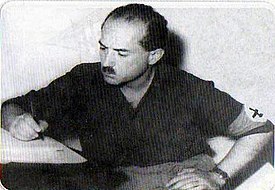Davud Monshizadeh
This article has multiple issues. Please help improve it or discuss these issues on the talk page. (Learn how and when to remove these template messages)
|
Davud Monshizadeh | |
|---|---|
 | |
| Born | 28 August 1914 |
| Died | 13 July 1989 (aged 74) Uppsala, Sweden |
| Alma mater | Friedrich Wilhelm University |
| Political party | SUMKA |
| Military career | |
| Allegiance | |
| Service/ | |
| Battles/wars | |
| Parent |
|
Davud Monshizadeh (
Iranian Languages at Uppsala University
, Sweden.
Career
Monshizadeh was born in Tehran, Iran. He is mainly remembered for his political life, most notably being the leader of SUMKA, but he is also recognized for his contributions to Iranian linguistics, particularly to the study of Modern and Middle Iranian languages.
Monshizadeh formed the
National Socialist German Workers Party (such as their militarism and salute), as well as attempting to approximate Hitler's physical appearance, including his moustache
.
He is buried at Uppsala Old Cemetery, Sweden.
Chronology
- 1931 - Sent to France by Iranian government to study.
- 1937 - Moved to Germany, a year after the Hitler Cabinet declared Iranians to be "pure-blooded Aryans" and immune to all Nuremberg laws, thus making them capable of becoming Reich citizens.[5]
- 1938 - Began his studies in Nazi Germany. He studied with Walther Wüst, with whom he developed a close bond.[6]
- 1939 - Monshizadeh and Bahram Shahrokh (the future Iranian Third Reich’s Deutsche Radio.
- 1940 - He started writing articles for Das Reich, the official newspaper of the Nazi Party
- 1941 - He worked with various organizations in the Third Reich
- 1943 - Obtained his doctorate in philosophy and literature from Berlin University.[7]
- 1945 - During the Battle of Berlin, he fought as a member of the SS. He was injured and hospitalized (off and on) till 1947.
- 1947 - Taught University of Munich.
- 1950 - He returned to Iran.
- 1951 - Along with Manouchehr Amir Mokri and Hussein Zarabi, he established the Iranian National Socialist Party (Sumka),[7] which played a role against oil nationalization in Iran.
- 1953 - Monshizadeh was "Unofficially Exiled" to Europe by Shah Mohammad Reza Pahlavi.
- 1963 - He left Iran in 1963 and came to Sweden on the initiative of Professor Iranology and Persian language at Uppsala University, eventually becoming Professor in Iranian Languages.
- 1989 - He died in Uppsala old cemetery(Uppsala gamla kyrkogård).
Works
- Das Persische im Codex Cumanicus, Uppsala: Studia Indoeuropaea Upsaliensia, 1969.
- Topographisch-historische Studien zum iranischen Nationalepos, Wiesbaden: Abhandlungen für die Kunde des Morgenlandes, 1975.
- Wörter aus Xurāsān und ihre Herkunft, Leiden: Acta Iranica; Troisième série, Textes et mémoires, 1990.
- Die Geschichte Zarēr's, ausführlich komment. von Davoud Monshi-Zadeh, Uppsala: Studia Indoeuropaea Upsaliensia, 1981.
- Ta'ziya : das persische Passionsspiel / mit teilweiser Übersetzung der von Litten gesammelten Stücke von Davoud Monchi-Zadeh, Stockholm: Skrifter utgivna av K. Humanistiska vetenskapssamfundet, 1967.
- Vihrūd va Arang : justārhā-yī dar jughrāfiy-̄yi asāṭīr ̄va tārīkh-̄i Īrān-i sharqī, pazhūhish-i Josef Markwart; tarjumah bā iz̤āfāt az Davūd Munshī-Zādah, Teheran: Majmūʻah-'i Intishārāt-i adabī va tārīkhī, 1989. (in Persian)
References
- ^ "داوود منشیزاده؛ تنها ایرانی عضو حزب نازی". مجله اینترنتی برترین ها | پورتال خبری و سبک زندگی. April 17, 2024.
- ^ MONCHI-ZADEH, DAVOUD. Encyclopædia Iranica. Retrieved from: https://www.iranicaonline.org/articles/monchi-zadeh-davoud
- ISBN 9780674504691.
- ISBN 978-2-262-09919-0
- ^ Asgharzadeh, Alireza (2007). "Iran and the Challenge of Diversity: Islamic Fundamentalism, Aryanist Racism, and Democratic Struggles". Palgrave Macmillan., p. 92. [1]
- ^ MONCHI-ZADEH, DAVOUD. Encyclopedia Iranica. Retrieved from: https://www.iranicaonline.org/articles/monchi-zadeh-davoud
- ^ ISBN 9781107076068. Retrieved 5 March 2015.
